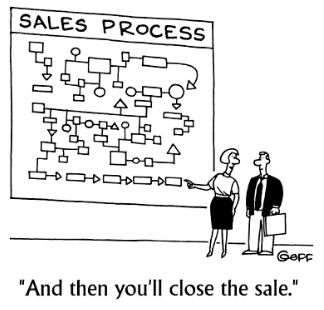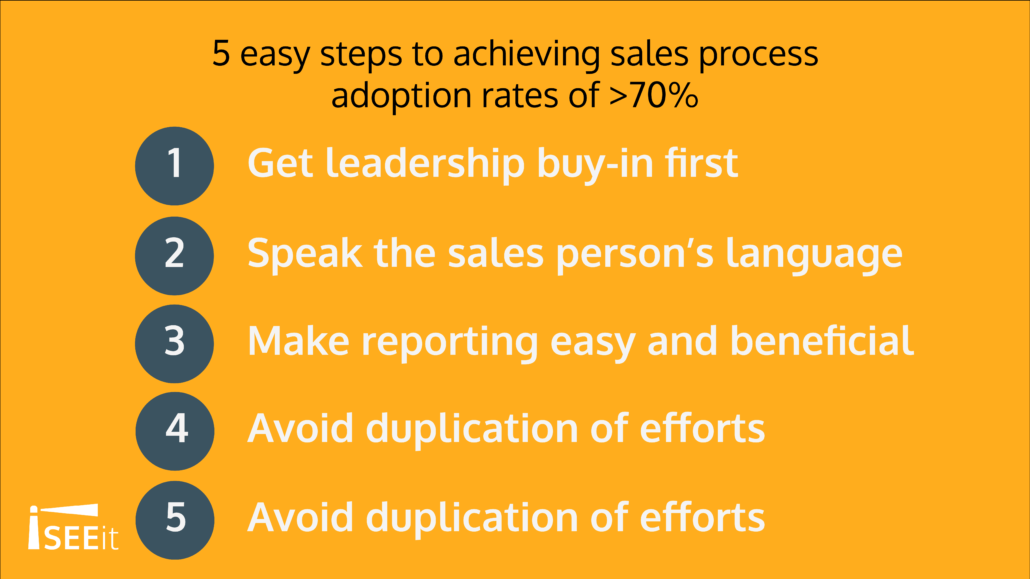Five Strategies to Achieve Sales Process Adoption Rates of 70% or Higher
Implementing a best practice sales process has a positive effect on win rates, forecast accuracy, and productivity per sales person. This is especially true for companies with expansion strategies. But, a sales process is only as effective as the sales people’s adoption of it.
Is getting your salespeople to change their processes like trying to get a 2-year-old to eat his broccoli? You are not alone.
Even if it’s obvious that the current processes are time-consuming, costly, and unproductive, it’s difficult to successfully motivate sales people to implement new ways of performing.

We partnered with our clients and outlined 5 steps to successfully implement a sales process and increase its adoption rate. They are:
- Get leadership buy-in first
- Speak the sales person’s language – “what’s in it for me?”
- Make reporting easy and beneficial to all contributors
- Avoid duplication of efforts
- Choose simplicity over complexity
Let’s look at each step in greater detail.
#1: Get leadership buy-in first.
Implementing a new sales process means that your sales team must change the way they do things. New behavior takes time to become second nature. It can easily lose steam and veer off track if sales teams feel like there are too many obstacles in the way or if these changes are perceived as too cumbersome.
We often hear complaints that sales people go back to their old ways after being back in the field. We can all agree it’s definitely different out in the field than in a classroom environment during a kick-off or training.
In the field, there will be many questions, uncertainties and doubts when implementing the newly learned sales process. Clients might not be willing to accept some of the sales process items, which will lead to sales people finding shortcuts, citing that “the new sales process” does not work.

Always make sure your first-line managers are fully bought in and are trained to explain the new processes. In this way, they will be able to address any objections and concerns. The managers who experienced success were knowledgeable and able to handle difficult questions. Additionally, they constantly reinforced the new process by inspecting and encouraging sales people to go the extra mile.
#2: Speak the sales person’s language “what’s in it for me?”
Sales people are creatures of habit. They rarely embrace processes and controls which dictate their behavior. They feel surveyed and deprived of their freedom to sell “their way” and are annoyed by the reporting as they feel micromanaged. Instead, they often rely on insights to guide their way of doing their job.
New sales processes get ignored because sales people don’t specifically understand how it is going to help them sell more, perform higher, and make more money for the company and themselves in the end.

Most managers then proceed to force it onto the sales teams. This “do it or you’re out” mentality works at first. However, it causes long-term issues like low adoption rates and inconsistent data.
The best way to get their support is to focus on them and their benefits by painting a picture of success supported and defined by real metrics like quota achievement and close rates. These measurable KPIs can help underpin the effectiveness of a sales methodology based on that of their peers.
For example, if Bill’s close rate is 90% and yours is just 60%, it might be a sign to sniff out exactly how Bill’s process differs from yours.
Before dismissing sales process adoption, these metrics should be discussed and closely reviewed. These conversations give sales reps clear knowledge based on evidence specifically when it comes to how the adoption process will help them achieve higher sales and bigger commissions.
#3: Make the reporting easy and beneficial to all contributors
We have seen sophisticated spreadsheets or countless additional fields in CRM systems, which require salespeople to enter opportunity data. When we interviewed them on how helpful they found this, we got answers like “I am entering data I already know! This is clearly designed for management reporting.” Bottomline was, the salespeople didn’t deem it beneficial at all.
When we asked how they could benefit from sharing the opportunity data, their responses took an interesting turn. “Reduce the time used for reporting and forecasting” was the number one response. This was followed by “Understanding where we stand in a deal and get some potential next steps to overcome hurdles.”

Ending up with accurate and up-to-date data to feed into reports should only occur if salespeople enter the data for their own purposes and use it in their selling activities.
Successful organizations therefore tied the allocation of sales supporting resources such as business specialists, technical resources or legal to underlying data in the system.
#4: Avoid duplication of efforts.
While we’ve seen companies introduce central sales process management, reps still had to fill out additional spreadsheets and other documentation tools for local managers or business lines.
I personally worked for a company where reps had to fill out seven spreadsheets, plus enter the data into the CRM for global reporting! Such duplication destroys any effort to get reps’ buy-in, which leaves little motivation for sales process adoption.

5: Choose simplicity over complexity
We found an interesting habit of over modeling a sales process. For some reason, many companies initially design very prescriptive sales processes which are many time too complex and rigid. Furthermore, they are full of qualification items, sub-processes and approval gates. This is confusing and leaves almost no space to adapt to the customers’ buying cycles, or for creativity to overcome hurdles.
In many cases, this led to salespeople saying that “The new sales process doesn’t work” or “the sales process is not designed for my region or the type of clients or products I sell.” The sales reps then end up feeling like robots interrogating the clients like an automated voice machine. As a result, engagement and adoption rates plummet.

Sales & sales management, together with sales ops and sales enablement need to be deeply involved in the design process. It might take a little bit longer to streamline the best practice approach, define the KPIs for reporting and map out the enablement strategy. However, it’s better to spend that extra time before the roll out than trying to circle around and do damage control after that.
Conclusion:
Implementing a consistent, repeatable sales (qualification) process is crucial to scaling your sales. By following these 5 steps, sales leaders can arm themselves with tools that will increase the rate of sales process adoption. This will create a more cohesive and well-executed team unit, and increase the overall closing ratio. Click here to find out how you can embed your sales process on Salesforce.








Businesses can streamline their sales process with the assistance of Sales Tracking Software. Thanks you for sharing an useful post.